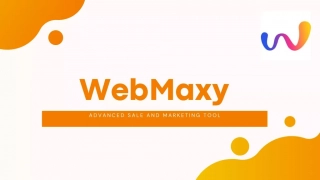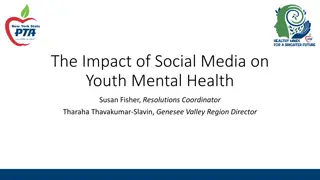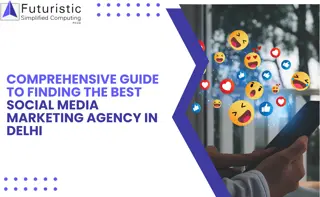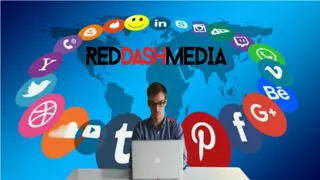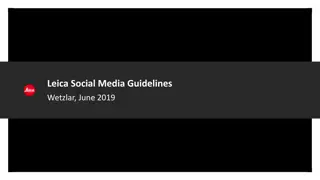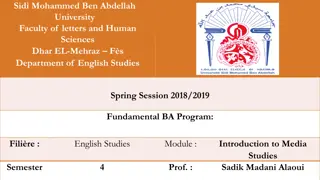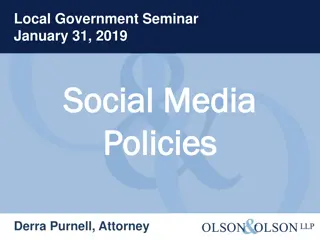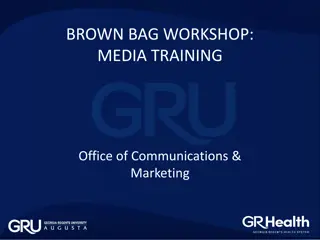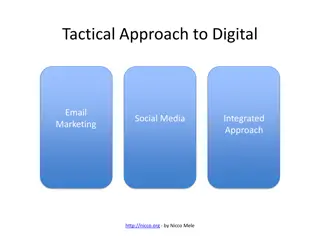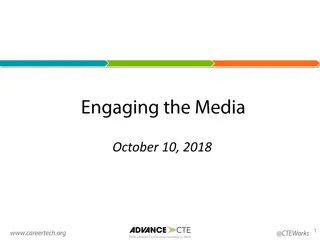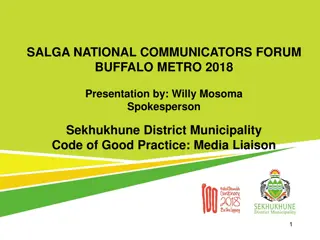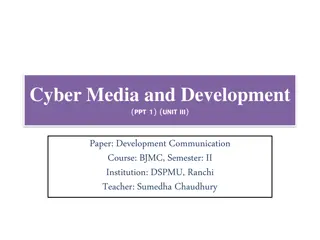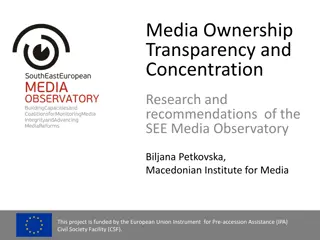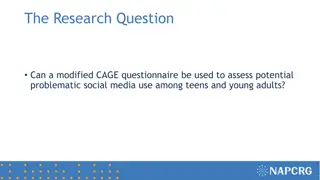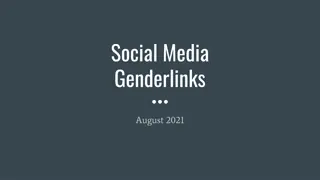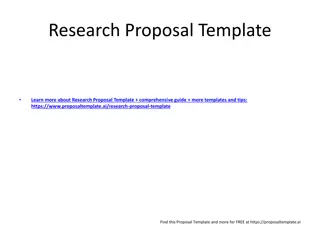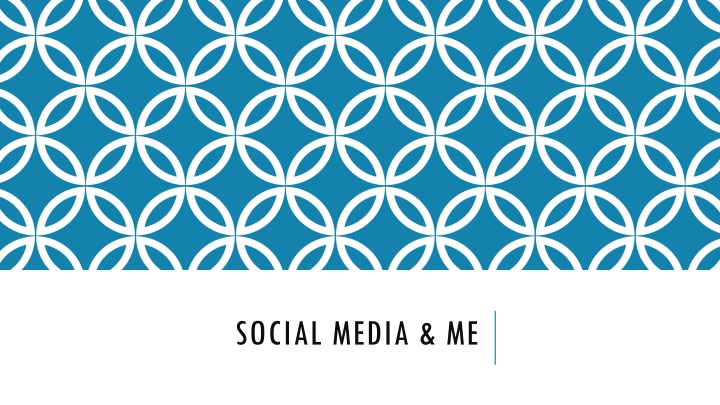
Changing Perspectives on Social Media and Information Consumption
Social media has revolutionized how we consume and understand information, serving as a primary news source for many. However, the accessibility has led to misinformation, emphasizing the importance of verifying information before sharing. Online social interactions offer value by connecting individuals, yet caution is advised in sharing personal details. Furthermore, social media influences youth culture by rapidly spreading trends and ideas.
Download Presentation

Please find below an Image/Link to download the presentation.
The content on the website is provided AS IS for your information and personal use only. It may not be sold, licensed, or shared on other websites without obtaining consent from the author. If you encounter any issues during the download, it is possible that the publisher has removed the file from their server.
You are allowed to download the files provided on this website for personal or commercial use, subject to the condition that they are used lawfully. All files are the property of their respective owners.
The content on the website is provided AS IS for your information and personal use only. It may not be sold, licensed, or shared on other websites without obtaining consent from the author.
E N D
Presentation Transcript
HOW HAVE CHANGED THE WAY WE CONSUME AND UNDERSTAND INFORMATION?
Social media had become the main source of new for many people because of how easily accessible it is. Anyone can create an account and post whatever they'd like. This causes many people to make up news or exaggerate news for attention. Many people will not look up or check the sources of what's being said, which can lead to spreading misinformation.
WHEN YOU SEE OR READ NEWS ON SOCIAL MEDIA, DO YOU TAKE TIME TO RESEARCH THE STORY FURTHER?
When I see something that I think is important and could affect my life or others, I take the time to search it up and find a reliable source with more information. Although I do not do this with every post I come across, if I am telling other people about what I saw, I make sure to check as to not spread misinformation. Doing this assignment, I realized I need to do this more often.
WHAT VALUE DO YOU GET FROM ONLINE SOCIAL INTERACTIONS?
Social media allows us to connect with others online. As an example, this can be good for communicating with friends or family we can't see in person. Another good example of a good value from online social interactions is talking to others who have the same interest as you. This all comes with a few risks. Being online, you must still be wary of the information you are sharing about yourself, and the people you are interacting with.
HOW IS SOCIAL MEDIA AND SOCIAL CAPITAL HELPING TO FORM YOUTH CULTURE?
Social media causes new trends, ideas, and ways of thinking to form and spread around easily. New fashion trends, slang, music, and more quickly become popular, which can be fun and entertaining for youth. Negative things are caused by this too, like ways of thinking. For example, social media platforms Tumblr caused many youth to develop eating disorders by glamorizing/romanticizing them. Many youth look up to creators they follow, and since they can post whatever opinions they like, if they post something negative, it can cause a person's entire way of thinking.
WHEN YOU POST ONLINE DO YOU CONSIDER HOW THE POST MAY BE SEEN BY OTHERS? WHAT IT MAY SAY ABOUT YOU? OR HOW THAT POST MAY BE SEEN IN THE FUTURE?
Before I post something online, I consider how other people will view my post. I do not post anything that I wouldn't want anyone important, such as future employers, schools or family, to see. I also consider how the post will affect my image and future.
DO YOU SEE ANY SIMILARITIES BETWEEN THE WORLD PRESENTED IN THIS VIDEO AND THE WORLD YOU LIVE IN?
The similarity between the video and reality is how people judge others from their posts, and the way people decide to present themselves on social media. Social media only shows snippets of people's lives, and often we decide to only show the best parts in order to create a "perfect" image. The video is trying to show how important presenting yourself in a good way on social media is for some parts of your life.
HOW DOES THE MAIN CHARACTER GAIN AND LOSE POINTS? WHY ARE THESE POINTS IMPORTANT TO HER?
The character gains and loses points from how people judge her, not if she is doing something good or bad. Social media doesn't accurately show what a person is like since they only post the good things. These points are so important to the character because she needs others to like her in order for her to live an easy life.
WHAT VALUE MIGHT BE DERIVED FROM THIS TYPE OF SOCIAL INTERACTION?
This type of social interaction is shallow and doesn't show what a person is like. For example, a bad person can still post things that make them seem kind, and no one online will ever know they're a bad person because of how they choose to represent themselves online. In the video, these the way the character interacts with others has no value because it's only to make them seem "good."
HOW ARE SOCIAL INTERACTIONS CHANGED IN THE WORLD OF THESE CLIPS?
In these clips, social interactions seem to only be made to try to create a sense of "perfection." People with more points (higher ranking), don t interact with those of few points because they don't want their own score to be affected. Those of less points are discriminated against, no matter how hard they work or if they're a good person. In this world, it would be hard to have a genuine relationship with someone and still have many points because of how the only thing that matters is others' opinions of you.
CRITICAL THINKING
HOW DID YOU TELL THE DIFFERENCE BETWEEN FACTS AND INTERPRETATIONS, OPINIONS AND JUDGEMENTS?
I kept in mind that facts have hard evidence and are indisputable, whereas with interpretations try to explain the fact's significance. The difference between opinions are judgements are that opinions are based on one's personal beliefs whereas judgements evaluate evidence to make a decision. I kept this in mind while working on this project as to not create anything biased.
HOW DID YOU ANALYZE EVIDENCE FROM DIFFERENT PERSPECTIVES?
When analyzing information, I made sure to put myself in others' positions as well. This made it so I could understand their perspectives easier and analyze information in the best way possible.
Horgan, C. (2019, October 16). Confusion is the point. Retrieved March 05, 2021, from https://gen.medium.com/the-confusion-is-the-point-6ab1d5a933aa Lee, S. (2016, April 14). Why eating disorders are so hard for instagram and tumblr to combat. Retrieved March 03, 2021, from https://www.buzzfeednews.com/article/stephaniemlee/why- eating-disorders-are-so-hard-for-instagram-and-tumblr-to#:~:text=The%20image- heavy%20nature%20of%20Instagram%20and%2C%20to%20a,needs%20help%20when%20th ey%E2%80%99re%20constantly%20inventing%20new%20hashtags. Loebig, B. (2020, May 07). Social media Marketing SILVER spring: How does social media Affect youth? |. Retrieved March 03, 2021, from https://www.loebigink.com/how-does-social-media- effect-youth/ Martin, N. (2018, November 30). How social media has changed how we consume news. Retrieved March 03, 2021, from https://www.forbes.com/sites/nicolemartin1/2018/11/30/how-social- media-has-changed-how-we-consume-news/?sh=13080ab3c3ca Opinion vs. judging. (2020, May 11). Retrieved March 05, 2021, from https://www.askdifference.com/opinion-vs-judging/

